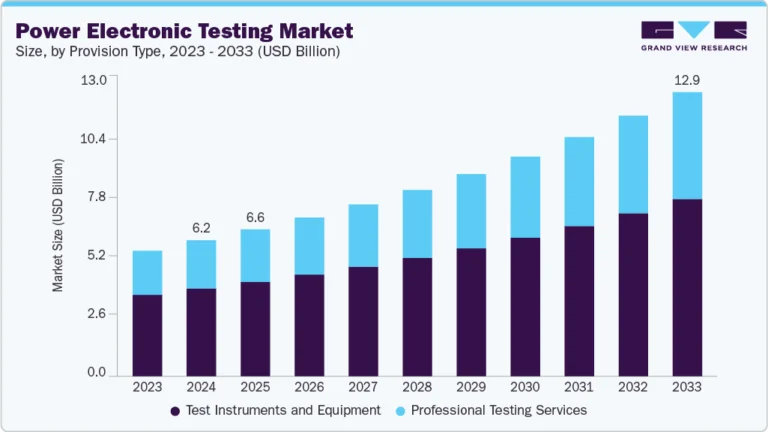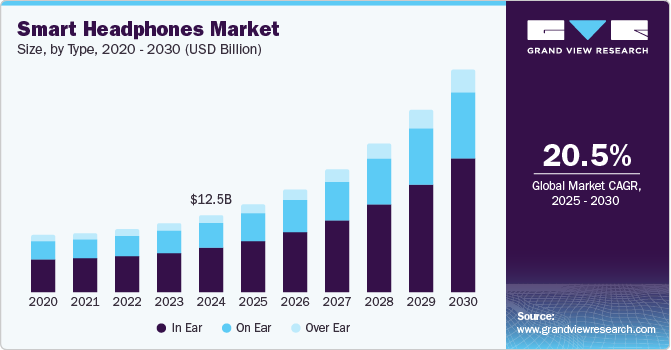Smart TV Market Size, Share & Trends Analysis Smart TV Market Size, Share & Trends Analysis

The global smart TV market size was estimated at USD 227.52 billion in 2024 and is projected to reach USD 451.26 billion by 2030, growing at a CAGR of 12.8% from 2025 to 2030. The market is witnessing growth due to integrated streaming services and internet connectivity. As consumers shift away from traditional cable and satellite services, Smart TVs allow easy access to on-demand streaming platforms, gaming, and social media, all within a single device.
Key Market Trends & Insights
- The smart TV market in Asia Pacific region accounted for a significant market share of approximately 39.1% in 2024.
- The smart TV market in U.S. is witnessing significant growth.
- Based on screen size, the 46 to 55-inch smart TV segment commands a high market share due to the versatility and suitability of this screen size for a wide range of living spaces.
- In terms of distribution channel, online segment captured a significant revenue share in 2024 due to the convenience and variety available through e-commerce platforms.
Market Size & Forecast
- 2024 Market Size: USD 227.52 billion
- 2030 Projected Market Size: USD 451.26 billion
- CAGR (2025-2030): 12.8%
- Asia Pacific: Largest market in 2024
Request a free sample copy or view report summary: https://www.grandviewresearch.com/industry-analysis/smart-tv-industry/request/rs1
Besides is the advancement in high-definition display technology, like 4K and 8K resolutions, which enhances the viewing experience and fuels consumer interest. Growing internet penetration, especially in developing regions, further supports this demand, as it enables access to online content and connectivity. Additionally, the decreasing cost of manufacturing Smart TVs has made them more affordable, boosting their adoption globally. Governments worldwide are implementing various initiatives to stimulate the growth of the Smart TV industry as part of broader digital transformation strategies. Many countries are incentivizing the production and adoption of electronic goods, including Smart TVs, through subsidies, tax incentives, and reduced import duties to attract foreign investment and encourage domestic manufacturing.
In some regions, governments are enhancing internet infrastructure, which indirectly benefits Smart TV sales by providing a stable and fast connection necessary for streaming. For instance, initiatives to increase digital literacy and subsidize internet access help more people explore Smart TVs’ benefits, contributing to the overall market expansion.
The smart TV industry holds significant growth opportunities, particularly in emerging markets where internet access and technology adoption rates are rapidly increasing. As the demand for content streaming continues to rise, there’s an opportunity for brands to offer affordable, feature-rich Smart TVs tailored to the needs of price-sensitive customers. Furthermore, advancements in artificial intelligence (AI) and voice recognition create potential for Smart TVs to act as central hubs in connected homes, thus opening avenues for cross-industry partnerships with smart home device manufacturers. Gaming is also a notable growth area, as smart TVs evolve to support cloud gaming services, appealing to a broad, global audience of gamers.
Manufacturers are actively investing in research and development to expand their presence in the Smart TV industry, driven by the high demand for interactive home entertainment solutions. Many leading brands are collaborating with streaming platforms, providing consumers with exclusive access to popular streaming services directly through their TV interface. By offering models across various price points and emphasizing innovation in screen technology, manufacturers aim to appeal to both high-end and budget-conscious customers. Additionally, they are focusing on expanding their distribution networks and exploring new sales channels, such as e-commerce platforms, to increase product accessibility and reach wider audiences.
Technological innovation continues to propel the market forward, as new features improve user experience and integrate seamlessly with other devices in the digital ecosystem. High Dynamic Range (HDR), Quantum Dot, and OLED technologies have significantly improved display quality, providing sharper images and vivid colors that enhance viewing satisfaction. In addition, integration with AI has enabled voice-activated controls, content recommendations, and even personalized viewing experiences. Furthermore, advancements in Internet of Things (IoT) connectivity allow Smart TVs to function as smart home hubs, enabling users to control lighting, thermostats, and security systems directly through their TV. These innovations position smart TVs as versatile, essential devices in the modern connected home.
Resolution Insights
The 4K Ultra High Definition (UHD) segment holds a substantial share in the smart TV market, largely due to the increasing demand for high-resolution displays that deliver clearer and more immersive viewing experiences. The 4K resolution, which offers four pixels of Full HD, has gained popularity as more content becomes available in this format. Streaming platforms, gaming, and even social media videos are now frequently offered in 4K, making it an attractive choice for consumers looking for high-quality visuals. The price of 4K UHD TVs has also decreased over time, which has helped make them more accessible to a broader market segment.
Full HD TVs continue to experience steady growth in the smart TV industry as they offer a high-quality viewing experience at a more affordable price than 4K models. Full HD remains a popular choice for consumers in regions with limited internet bandwidth where 4K streaming may not be feasible. As a result, Full HD Smart TVs provide an optimal balance of quality and price, especially for budget-conscious consumers who want smart features without necessarily needing ultra-high resolutions. This segment appeals to a diverse range of customers and remains particularly strong in emerging markets.






